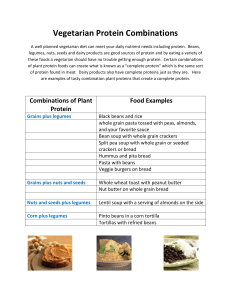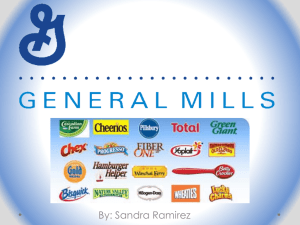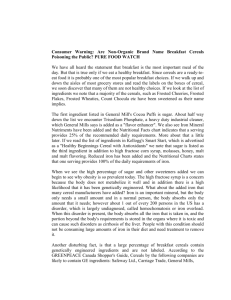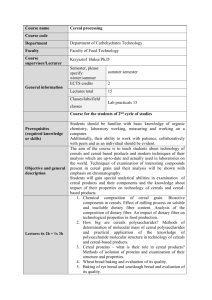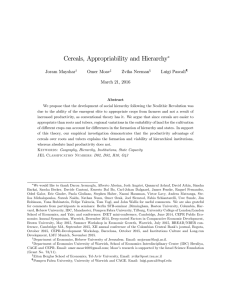NUD 201 - The Federal University of Agriculture, Abeokuta
advertisement
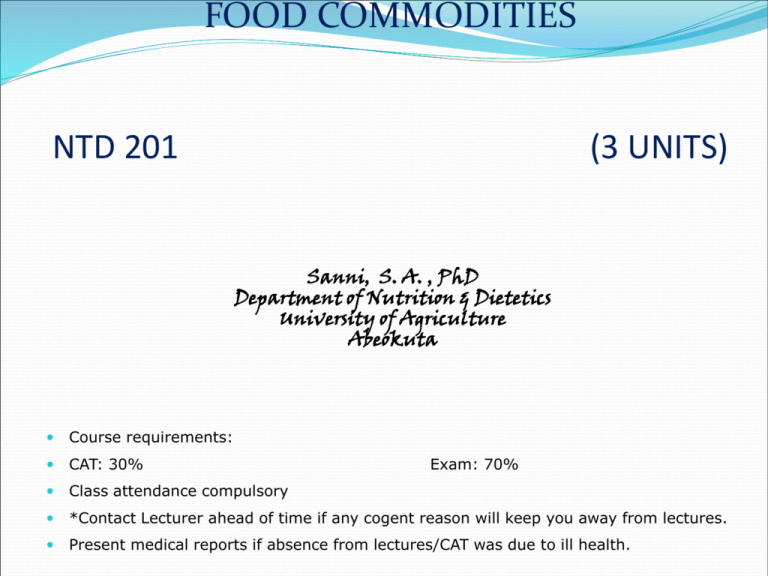
FOOD COMMODITIES NTD 201 (3 UNITS) Sanni, S. A. , PhD Department of Nutrition & Dietetics University of Agriculture Abeokuta Course requirements: CAT: 30% Class attendance compulsory *Contact Lecturer ahead of time if any cogent reason will keep you away from lectures. Present medical reports if absence from lectures/CAT was due to ill health. Exam: 70% Synopsis Food Classification Market Surveys Food Selection & purchasing Uses of Foods Foods and Food tables Cereals, Starches & starchy foods, Sugars, Pulses, nut and seeds Vegetables and fruit Meat, fish etc. Infective agents in food Natural food toxins Food Defined Food is any substance that is consumed to provide nutritional support for the body, possibly to the point of excess. It is usually of plant or animal origin, and contains essential nutrients, such as carbohydrates, fats, proteins, vitamins, or minerals. The substance is ingested by an organism and assimilated by the organism's cells in an effort to produce energy, maintain life, and/or stimulate growth. Food Classification Food Selection & purchasing The types of food you select depends on: the money you have your nutritional needs and the effect of advertisements Now let us examine each of these factors and see how they influence our selection or choice of food! Nutritional needs Your food choice will also depend on your need for food. Everyone has a biological need for food. It is essential for life without food one becomes weak and ill. People vary in the amount of food they need for reasons like health, age and activity. Your choice of food will therefore depend on each of these factors. Your nutrition knowledge helps you to choose food that provides the necessary nutrients to meet your needs. Food Purchasing Food purchasing can be a boring or interesting adventure depending on one’s approach to it. To make food purchasing interesting you have to know much about the market place and ways in which you can make the most out of your food budget. Now let us look at some of the things you can do to avoid waste of your time and money when purchasing food. First of all you need to know the factors that determine the cost of the things you want to purchase. Foods and Food tables Foods Rich in -------------------Carbohydrates------------------- Fats Proteids Chocolate Honey Vegetables - Butter Cheese Vegetables - Fruits - Nuts - Asparagus Cheese Eggs Asparagus Dates Chestnuts Bananas Chocolate Fish Beet-tops Figs Peanuts Beets Cream Legumes - Cabbage Grapes Pignolia or Cabbage Nuts - Beans - dried Carrots Persimmons pine nuts Carrots Almonds Lentils - dried . Celery Raisins Sirups Celery Brazil-nuts Peas - dried Dandelion Grains - Sugar Lettuce Cocoanuts Milk Green peas Barley Tapioca Onions Hickory- Nuts - Lettuce Corn Parsnips nuts Peanuts Onions Oats Potatoes - Peanuts Pignolia or Radish-tops Rice sweet Pecans pine nuts Romaine Rye Potatoes - Pignolia or Poultry Spinach Wheat white pine nuts Vegetables - String beans Pumpkin Walnuts Cabbage Turnip-tops Spinach Oils - Lettuce Watercress Squash Cottonseed Onions Wheat bran Turnips Nut-oil Spinach Olive-oil Turnips Wheat bran Mineral Salts CEREALS Cereals are the edible seeds or grains of the grass family. There are many different types of cereal grains, each having unique properties. Most cereals are processed to form other foods or ingredients. Cereals and cereal products are an important source of energy, carbohydrate, protein and fibre. They also contain a range of micronutrients such as vitamin E, some of the B vitamins, sodium, magnesium and zinc. Wheat and rice are the most important cereal crops world-wide as they account for over 50% of the world’s cereal production. TYPES OF CEREALS Wheat: is usually ground to flour which is used to produce a wide range of products. The type of flour produced differs according to the rate of extraction. Couscous and cracked wheat or bulgur is also made from wheat. Wheat can be fermented to make beer. Maize: (or corn) may be processed to make many different ingredients (e.g. high fructose corn syrup which can be used as an alternative to sucrose derived from sugar cane and sugar beet) and food products. It may be milled in a similar process to wheat. Its germ is rich in oil, and can be refined to produce corn oil. Barley: is mainly sold as pearl barley, which is the whole grain with its husk removed. It is also used in bread (as flour) and ground as porridge in some countries. Rice: brown rice has its outer husk removed, and white rice is milled and polished further to remove the bran and germ. There are many different types of rice, categorized by size, shape and the region where they are grown. Rice can be ground to make flour and is used to make Japanese rice wine (saké). Rye: contains little gluten, so produces breads with low volume and a dense texture, although in Russia, Poland, Germany and Scandinavian countries it is the major bread grain. Rye is also used to produce crisp bread and alcohol. Oats: are rolled rather than crushed during processing. Coarse, medium and fine grades of oatmeal are available and are used for porridge and oatcakes, while rolled oats are used for porridge, and oat flour is used for baby foods and for ready-to-eat (RTE) breakfast cereals. Millet: is the name used for a number of different small-grained cereal grasses, e.g. pearl, finger (or ragi), proso and foxtail millet. These crops are important in parts of Africa and Asia. Sorghum: (also known as great millet, guinea corn, kafir corn, jowar and kaoling in different parts of the world) is a staple food in many parts of Africa, Asia and parts of the Middle East. It is also used as animal feed in many other countries. NUTRITIONAL VALUE OF CEREALS AND CEREAL PRODUCTS Cereals and cereal products are an important source of energy, carbohydrate, protein and fibre. They also contain a range of micronutrients such as vitamin E, some of the B vitamins, sodium, magnesium and zinc. Because of the fortification of some cereal products they also contribute significant amounts of calcium and iron. There is evidence to suggest that regular consumption of cereals, specifically whole grains, may have a role in the prevention of chronic diseases. The strength of evidence varies and although cause and effect has not currently been established, people who consume diets rich in whole grain cereals seem to have a lower incidence of many chronic diseases, e.g. coronary heart disease and type 2 diabetes. It remains to be established whether this is a direct effect, or whether whole grain consumption is merely a marker of a healthy lifestyle or some other factor. Structure of the maize kernel (caryopsis) Essential Amino Acid Content of Cereal Proteins Essential Amino Acids Percentage content Rice Corn Wheat Arginine 8.40 9.36 24.06 Histidine 2.60 0.75 7.89 Isoleucine 4.50 0.80 0.00 Leucine 8.40 31.22 33.91 Lysine 3.50 6.71 5.88 Methionine 2.50 2.35 4.84 Phenylalanine 4.50 9.34 8.40 Threonine 3.90 2.90 2.00 Tryptophan 1.20 2.07 8.14 Valine 6.50 1.88 3.85 ROOTS AND TUBERS Roots are plant materials which edible portions grows under the soil but the stem serve as planting materials, while tubers are thick parts or swollen parts of an underground stem bearing small buds from which new plants can be formed. Roots and tubers belong to the class of foods that basically provide energy in the human diet in the form of carbohydrates. The principal root and tuber crops of the tropics are cassava (Manihot esculenta Crantz), yam (Dioscorea spp.), sweet potato (Ipomoea batatas L.), potato (Solanum spp.) and edible aroids (Colocasia spp. and Xanthosoma sagittifolium). They are widely grown and consumed as subsistence staples in many parts of Africa, Latin America, the Pacific Islands and Asia. The increased use of major roots and tubers – cassava, potato, sweet potato, and yam, for food and livestock feed in developing countries will have wide-ranging effects on global public- and private-sector policies and investments. Roots and tubers will continue to play a significant role in developing-country food systems because they: a. contribute to the energy and nutrition requirements of more than 2 billion people; b. are produced and consumed by many of the world’s poorest households; c. are an important source of employment and income in rural, and often marginal, areas, especially for women, and d. d.adapt to a wide range of uses, from food-security crops to cash crops, raw material for industrial uses, and from fresh to high-end processed products. Roots and tubers together constitute a significant share of the total volume and value of horticultural crops worldwide. These commodities are particularly important as a source of food, employment, and income in developing countries where the bulk of the world's producers, processors, and consumers reside. In this new millennium, roots and tubers will play Cereals and oil seeds Roots and tubers 1.Low moisture content, typically 10% to 15% High moisture content, typically 70% to 80% 2. Small unit size, typically less than 1 gram Large unit size, typically 100 grams to 15 kg 3. Very low respiration rate with very low generation of heat. Heat production is typically 0.05 megajoule/ton/day for dry grain 4. Hard texture High respiration rate. Heat production is typically 0.5 to 10 megajoules/ton/day at 0°C to 5 to 70 megajoules/ton/day at 20ºC Soft texture, easily bruised 5. Stable, natural shelf life is several years Perishable, natural shelf life is a few days to few months 6. Losses usually caused by moulds, insects and rodents Losses usually caused by rotting (bacteria and fungi), senescence, sprouting and bruising Chemical Composition of some Tropical Roots and Tubers Commo Dry Crude Ether Total dity Phosphorus Fe Matters Protein extract ash (g) (g) (g) (g) (mg) Energy Ascorbic Calcium (cals) acid (mg) (mg) (mg) Cassava 31.94 2.71 0.53 2.66 390.0 35.0 10.0 35.0 0.50 Yam 26.17 5.87 0.46 4.30 385.9 17.0 18.9 40.7 0.48 Cocoya m (Taro) 26.5 2 8.66 0.71 4.83 376.4 14.0 24.0 53.6 0.72 Cocoya 24.8 m 9 (Tannia) 7.85 0.70 5.22 382.6 10.0 6.0 360.0 0.70 Sweet Potato 5.36 0.33 3.15 391.0 26.2 16.6 31.0 0.83 28.0 8 Pulses (Legumes) Legumes are widely distributed world- wide and generally referred to as pulses. Every zone of the world has some legumes peculiar to them. For example, in France, groundnuts are found, in South America, lima and runner beans, in the United States, soya beans and in Africa, cowpeas, bambara nut, broad beans, in India, lentils and chick peas etc. The fruit is a pod containing seeds ranging generally from 2-10 seeds. There are two main types of legumes, viz : I. Those containing high protein and high oil content. II. Those containing moderate protein and low oil content. Examples of the first group include soya bean, groundnut, lupin and winged beans. The protein content is as high as 35% while oil content vary from 15 - 45%. Examples of the second group include cowpea, gram, pea, bambara groundnut, lentil and the different varieties of the phaseolus group. The protein content is in the range of 25- 30% while the oil content is less than 5%. Legumes are generally high in B vitamins but low in sulphur containing amino acids, methionine and cystine. They have high content of lysine which makes legumes a good complement to cereals (cereals are low in lysine but high in methionine). Legumes have some nutritional disadvantages apart from being deficient in methionine and cystine. These are of low digestibility and the consumption of high proportion of legumes in the diet can cause flatulence. Some legumes contain toxic substances which interfere with normal enzymic reactions. Composition of some Legumes Legumes Moisture (g) Energy (KJ) Protein (g) Fat (g) Total Carbohydrates(g) Bambara groundnut 10 1550 20 6 60 Black eye Beans(raw) 13 1360 23 1.5 58 (Decorticated) 30 1080 20 1.2 44 (Moi- moi) 70 500 7 2 20 (Akara) 60 920 9 15 14 Black gram (Urad dahl) 10 1450 24 1.5 60 Chick pea (Bengal gram) 11 1360 20 5.6 60 Humous (Chick pea paste) 60 770 8 13 11 Groundnut (Dry) 5 2570 26 48 20 Lentil (Masar dahl 12 1300 20 0.6 65 Lima (Butter) Bean 12 1162 20 1.5 58 Mung Bean 12 980 22 1.0 35 (Sprouts) 90 146 3.8 0.2 6 Pea 78 280 5.8 0.4 11 Soya Bean 10 1700 40 20 20 Winged Bean 10 1700 33 17 37 Composition of some Fruits Comm odity Wate r (%) Energ y (cal) Protei n (%) Fat (%) Carbo Ascor hydra bic te (%) acid (%) Calci um (%) Phos phor us (mg) Vit. A (i.u) Banana 75 86 1.1 0.2 24 10 8 26 190 Pineap ple 85 65 0.4 0.4 15 110 20 11 30 Mango 83 63 0.6 0.1 15 30 10 10 180 Guava 80 58 1.0 0.4 13 200 15 33 200 Orange 86 49 1.0 0.2 12 50 41 20 200 Lemon 58 1.0 0.9 11 43 40 22 - Cashew 85 apple - 0.7 - 13 250 10 - 150 Pawpa w-ripe 40 0.5 0.6 10 110 16 8 2200 Fruits 85 81 Composition of some Vegetables Comm odity Wate r (%) Energ y (cal) Protei n (%) Fat (%) Carbo Ascor hydrat bic e (%) acid (%) Calci um (%) Phosp Vit. A horus (i.u) (mg) Onions 89 38 1.5 0.1 9 10 27 56 40 Carrot 88 42 1.1 0.2 10 51 37 36 11000 Spinach 91 26 3.2 0.3 5 51 93 51 8100 Cabbag e 92 24 1.3 0.2 4 47 49 29 130 Pepper 92 22 1.2 0.2 4 125 9 22 420 Tomato 93 22 1.1 0.2 5 30 13 27 190 Composition of Meat and Meat Products Type % Composition of Edible Portion Water Protein Fat Ash Carbohydrate Beef (medium fat) 60.0 17.5 22.0 0.9 - Veal (medium fat) 66.0 18.8 14.0 1.0 - Pork (medium fat) 42.0 11.9 45.0 0.6 - Lamb (medium fat) 56.0 15.7 27.7 0.8 - Chicken 66.0 20.2 12.6 1.0 - Duck 52.8 16.2 30.0 1.0 - Turkey 58.3 20.1 20.2 1.0 - Fish (fillet non fat) 81.8 16.4 0.5 1.3 - Fatty fish fillet 68.8 20.0 10.0 1.4 - Crustaceans 79.3 14.6 1.7 1.8 2.6 Dried fish 4.0 60.0 21.0 15.0 - Milk (cow) 87.3 3.5 3.5 0.7 5.0 Cheese (hard) 37.0 25.0 31.0 5.0 2.0 % Composition of Raw Fish Flesh Lean Fatty Water 80 60-80 Protein 16-18 16-18 Lipids 0.5-2.0 5-20 Extractives(salts glycogen, amino acids 0.5-2.0 0.5-2.0 Mineral content 1.0-1.5 Lean: cod, haddock, whiting, rockfish, sole Fatty: Salmon, mackerel, trout, butterfish 1.0-1.5 Infective and Toxic Agents in Foods There are more than 200 known diseases that can be transmitted through food, however, and the known causes of food poisoning include infective agents and toxic agents. Infective agents include viruses, bacteria, and parasites. Toxic agents include poisonous mushrooms, improperly prepared exotic foods (such as barracuda), or pesticides on fruits and vegetables. Sources of Food Contamination Food usually becomes contaminated with these agents from poor sanitation or preparation. Food handlers who do not wash their hands after using the bathroom or have infections themselves often cause contamination. Improperly packaged food stored at the wrong temperature also promotes contamination. Three of the most important causes of food poisoning are the salmonella, clostridium botulinum and staphylococcal organisms. Further Readings Collingham, E. M. The Taste of War: World War Two and the Battle for Food (2011) Marion Nestle: Food Politics: How the Food Industry Influences Nutrition and Health, University Presses of California, revised and expanded edition 2007, ISBN 0520254031 Katz, Solomon. The Encyclopedia of Food and Culture, (Scribner, 2003) http://en.wikipedia.org/wiki/Food http://www.healthscout.com/ency/68/676/main.html
